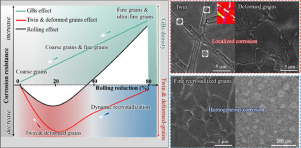当前位置:
X-MOL 学术
›
Acta Biomater.
›
论文详情
Our official English website, www.x-mol.net, welcomes your feedback! (Note: you will need to create a separate account there.)
Microstructure controls the corrosion behavior of a lean biodegradable Mg-2Zn alloy.
Acta Biomaterialia ( IF 9.7 ) Pub Date : 2020-02-29 , DOI: 10.1016/j.actbio.2020.02.040 Wenhui Wang 1 , Hongliu Wu 2 , Rui Zan 2 , Yu Sun 2 , Carsten Blawert 3 , Shaoxiang Zhang 4 , Jiahua Ni 5 , Mikhail L Zheludkevich 3 , Xiaonong Zhang 2
Acta Biomaterialia ( IF 9.7 ) Pub Date : 2020-02-29 , DOI: 10.1016/j.actbio.2020.02.040 Wenhui Wang 1 , Hongliu Wu 2 , Rui Zan 2 , Yu Sun 2 , Carsten Blawert 3 , Shaoxiang Zhang 4 , Jiahua Ni 5 , Mikhail L Zheludkevich 3 , Xiaonong Zhang 2
Affiliation

|
Microstructural design was a long-term sustainable development method to improve the biodegradability and mechanical properties of low alloyed biomedical Mg alloys. In this study, the microstructural features (including grain size, deformation twin, deformed grains, sub-grains, and recrystallized grains) of the MZ2 ((Mg-2Zn (wt%)) alloy were controlled by different single-passed rolling reductions at high temperature. Besides the effect of grain size, we found that deformation twins and deformed grains influenced corrosion performance. Grain refinement with uniform distribution, meanwhile reducing the content of deformation twins, deformed grains, and sub-grains, was a practical method to improve both corrosion resistance and mechanical properties of MZ2 alloy. This finding proposed a better understanding of the development of lean biomedical Mg alloys with superior mechanical properties and favorable corrosion resistance. STATEMENT OF SIGNIFICANCE: Current research and development of biomedical Mg focused on alloying methods. The lean biodegradable Mg, which reduced the materials' compositional complexity, was the benefit of development for long-term sustainability. Here, our work revealed the relationship between microstructural features and corrosion resistance of a lean Mg-2Zn alloy during the different single-passed rolling processes. We found that recrystallized fine grains with partially ultra-fine grains could improve both strength and corrosion resistance. This study could give a new understanding of the development of lean biodegradable Mg alloys by using microstructural design to improve the overall performance of biomedical applications.
中文翻译:

微观结构控制了一种可生物降解的贫Mg-2Zn合金的腐蚀行为。
显微组织设计是一种长期的可持续发展方法,旨在提高低合金生物医学镁合金的生物降解性和力学性能。在这项研究中,MZ2((Mg-2Zn(wt%))合金的显微组织特征(包括晶粒尺寸,变形孪晶,变形晶粒,亚晶粒和再结晶晶粒)是通过不同的单道次压下量控制的。除晶粒尺寸的影响外,我们发现变形孪晶和变形晶粒会影响腐蚀性能;晶粒细化且分布均匀,同时减少变形孪晶,变形晶粒和亚晶粒的含量,是一种可行的改进方法。 MZ2合金的耐腐蚀性和机械性能。这一发现提出了对具有优异机械性能和良好耐腐蚀性的贫化生物医学镁合金发展的更好理解。意义声明:当前生物医学镁的研究和开发集中在合金化方法上。贫化的可生物降解镁降低了材料的成分复杂性,这是开发对长期可持续性的好处。在这里,我们的工作揭示了在不同的单道次轧制过程中,贫Mg-2Zn合金的显微组织特征与耐蚀性之间的关系。我们发现,具有部分超细晶粒的再结晶细晶粒可以同时提高强度和耐腐蚀性。
更新日期:2020-03-02
中文翻译:

微观结构控制了一种可生物降解的贫Mg-2Zn合金的腐蚀行为。
显微组织设计是一种长期的可持续发展方法,旨在提高低合金生物医学镁合金的生物降解性和力学性能。在这项研究中,MZ2((Mg-2Zn(wt%))合金的显微组织特征(包括晶粒尺寸,变形孪晶,变形晶粒,亚晶粒和再结晶晶粒)是通过不同的单道次压下量控制的。除晶粒尺寸的影响外,我们发现变形孪晶和变形晶粒会影响腐蚀性能;晶粒细化且分布均匀,同时减少变形孪晶,变形晶粒和亚晶粒的含量,是一种可行的改进方法。 MZ2合金的耐腐蚀性和机械性能。这一发现提出了对具有优异机械性能和良好耐腐蚀性的贫化生物医学镁合金发展的更好理解。意义声明:当前生物医学镁的研究和开发集中在合金化方法上。贫化的可生物降解镁降低了材料的成分复杂性,这是开发对长期可持续性的好处。在这里,我们的工作揭示了在不同的单道次轧制过程中,贫Mg-2Zn合金的显微组织特征与耐蚀性之间的关系。我们发现,具有部分超细晶粒的再结晶细晶粒可以同时提高强度和耐腐蚀性。



























 京公网安备 11010802027423号
京公网安备 11010802027423号